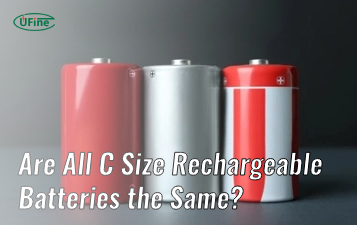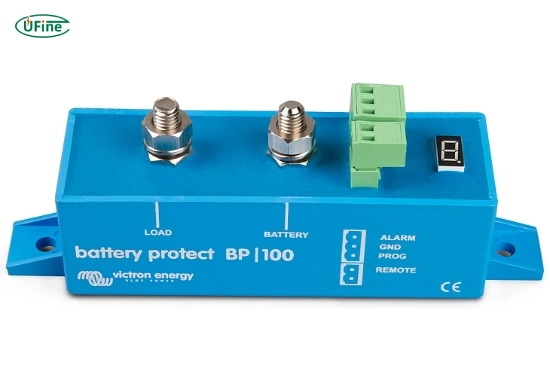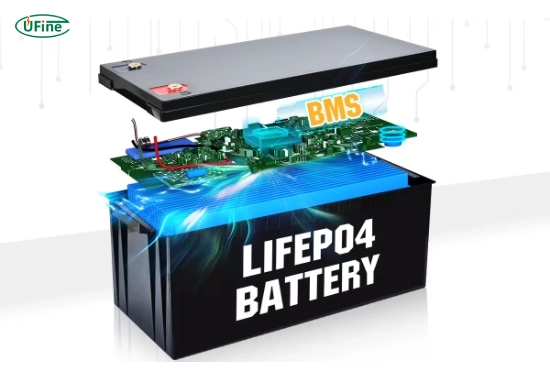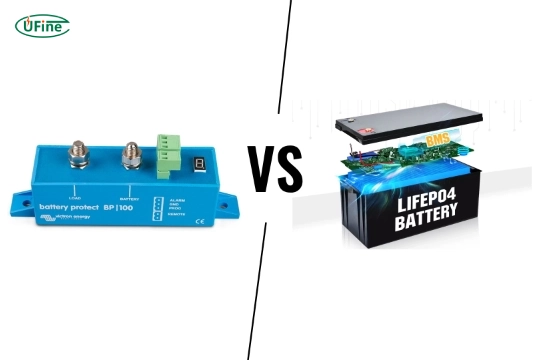
- Part 1. What is a battery protector?
- Part 2. What is a BMS (Battery Management System)?
- Part 3. What are the significant differences between a battery protector and a BMS?
- Part 4. Why is over-discharge dangerous for batteries?
- Part 5. What systems need a battery protector?
- Part 6. What systems need a BMS?
- Part 7. Can a battery protector and BMS work together?
- Part 8. How to choose the right battery protector?
- Part 9. How to choose the right BMS?
- Part 10. Common mistakes when using battery protectors or BMS
- Part 11. FAQs about battery protectors and BMS
Do you know the difference between a battery protector and a battery management system (BMS)? These two terms often confuse people looking to protect and extend the life of their batteries, especially in solar systems, RVs, or off-grid setups. The short answer is this: a battery protector prevents your battery from over-discharging, while a Battery Management System (BMS) controls and monitors charging, discharging, and battery health on a deeper level.
In this guide, we’ll clearly break down everything you need to know about battery protectors vs BMS. We’ll help you decide which one you need—or whether you might need both.
Part 1. What is a battery protector?
A battery protector is a small device that disconnects your battery before it becomes too discharged. This helps prevent deep discharge, which can damage a battery permanently.
Here’s how it works: when your battery voltage drops below a safe level, the battery protector cuts off the power flow to connected devices. Once the battery charges back up to a safe level, it reconnects the power.
Key features of a battery protector:
- Monitors voltage in real-time.
- Disconnects load when the voltage gets too low.
- Reconnects automatically at safe voltage.
- Protects battery lifespan by avoiding deep discharges.
Battery protectors are often used in leisure batteries, solar setups, and off-grid systems where over-discharge is a genuine concern.
Part 2. What is a BMS (Battery Management System)?
A Battery Management System, or BMS, is a more advanced system that monitors, balances and protects a battery or battery pack—especially lithium-ion batteries.
Unlike a simple battery protector, a BMS performs multiple protective functions, including:
- Overcharge protection
- Over-discharge protection
- Overcurrent protection
- Short circuit protection
- Temperature monitoring
- Cell balancing
A BMS is like the brain of your battery pack. It ensures each cell in a multi-cell battery operates safely and efficiently.
Part 3. What are the significant differences between a battery protector and a BMS?
Let’s break down the core differences between these two devices:
| Feature | Battery Protector | BMS |
|---|---|---|
| Primary Function | Prevents over-discharge | Full battery monitoring & control |
| Complexity | Simple device | Complex electronic system |
| Used With | All battery types | Mostly lithium-ion batteries |
| Balancing Feature | ❌ No | ✅ Yes |
| Temperature Monitoring | ❌ No | ✅ Yes |
| Overcurrent Protection | ❌ No | ✅ Yes |
| Reconnection Logic | Based on voltage | Based on multiple parameters |
A battery protector might be enough if you’re working with simple lead-acid or AGM batteries. But a BMS is essential for running lithium batteries, especially in large systems.
Part 4. Why is over-discharge dangerous for batteries?
Overdischarge occurs when a battery is drained too much. It can cause permanent damage, especially to lithium batteries.
When a battery discharges below its safe voltage:
- Lead-acid batteries can suffer from sulfation.
- Lithium batteries may shut down or fail.
- The battery’s lifespan is reduced.
This is precisely why a battery protector or BMS is so essential. They act as safety guards that kick in before damage is done.
Part 5. What systems need a battery protector?
You should consider adding a battery protector if you’re using:
- 12V leisure batteries in RVs or campervans
- Off-grid solar systems
- Boathouse battery systems
- Power banks and portable batteries
In these setups, appliances like fridges, lights, or fans may keep running until the battery drains completely. A battery protector stops this by cutting off the load at a safe voltage.
Part 6. What systems need a BMS?
You must have a BMS if you use:
- Lithium-ion (LiFePO4) batteries
- Battery packs with multiple cells
- High-current applications like e-bikes or solar storage
A BMS is non-negotiable in these systems. Lithium batteries are susceptible to overcharging or deep discharging. A BMS keeps the battery safe by monitoring every cell and balancing them regularly.
Part 7. Can a battery protector and BMS work together?
Yes, and in many cases, it’s a good idea to use both.
Even if you have a BMS, adding a battery protector as a backup can give you an extra layer of safety. It’s like having a second opinion before your battery gets too low.
For example, in an RV with a lithium battery and solar panels:
- The BMS manages internal battery safety.
- The battery protector disconnects the loads if the voltage drops too low.
This double-layer protection ensures maximum battery life and system reliability.
Part 8. How to choose the right battery protector?
When choosing a battery protector, consider these key specs:
- Voltage rating (12V, 24V, etc.)
- Current rating (how much current it can handle)
- Low voltage disconnect threshold
- Auto-reconnect voltage
- Load or charge side protection
Look for brands like Victron or Renogy if you want reliable, well-supported devices.
Part 9. How to choose the right BMS?
For a Battery Management System, you need to match it to your battery pack:
- Number of cells (3S, 4S, 8S, etc.)
- Battery chemistry (LiFePO4, NMC, etc.)
- Maximum charge/discharge current
- Communication features (Bluetooth, CANbus)
- Built-in protections
If you’re DIY-ing a battery pack, choose a smart BMS with an app or interface for real-time monitoring.
Part 10. Common mistakes when using battery protectors or BMS
Here are some mistakes to avoid:
- Using a battery protector with the wrong voltage range
- Relying on a battery protector alone for lithium batteries
- Not understanding your battery’s voltage thresholds
- Skipping cell balancing in lithium packs
- Overloading your system without proper current protection
Always read the manuals and make sure your system is matched correctly.
Part 11. FAQs about battery protectors and BMS
Can I use a battery protector with a lithium battery?
Yes, but only as a secondary protection. Lithium batteries must have a BMS. A battery protector adds extra protection on the load side.
Is a BMS enough to prevent battery damage?
Usually, yes. A good BMS provides full protection. But in complex systems, pairing it with a battery protector can help protect external loads.
Do I need a battery protector for lead-acid batteries?
Yes, especially in solar or RV setups. A battery protector keeps lead-acid batteries from discharging too deeply, which damages them over time.
What’s the best low-voltage cutoff for a 12V battery?
For lead-acid batteries, around 11.8V to 12.0V is a safe cutoff. Depending on the BMS specs, cut off around 10.5V to 11.0V for lithium.
Can I install a battery protector myself?
Yes! Most protectors are plug-and-play. Just install it between your battery and the load. Make sure to follow the manual and use proper wire sizes.
Related Tags:
More Articles

Are All C Size Rechargeable Batteries the Same?
Compare rechargeable C cell batteries by type, voltage, capacity, and lifespan. Find the best C batteries for toys, flashlights, and emergency devices.
Learn how to safely recharge 18650 batteries, choose the best 18650 battery charger, and extend battery life with expert tips and practical strategies.
12 Volt Batteries: How Long Can They Really Last?
Discover the real lifespan of 12V batteries. Compare lead-acid, AGM, gel, and lithium (LiFePO₄) batteries — and find out why LiFePO₄ lasts over 10 years.
Lithium-ion vs Lithium Polymer Battery: Which is Better?
Compare Li-ion and LiPo batteries in energy, safety, lifespan, and uses. Learn which battery is best for drones, laptops, and wearables.
Power Pack Battery vs. Power Bank: What’s the Difference?
Compare power pack battery and power bank: capacity, devices, portability, and best uses to pick the right portable battery pack.





